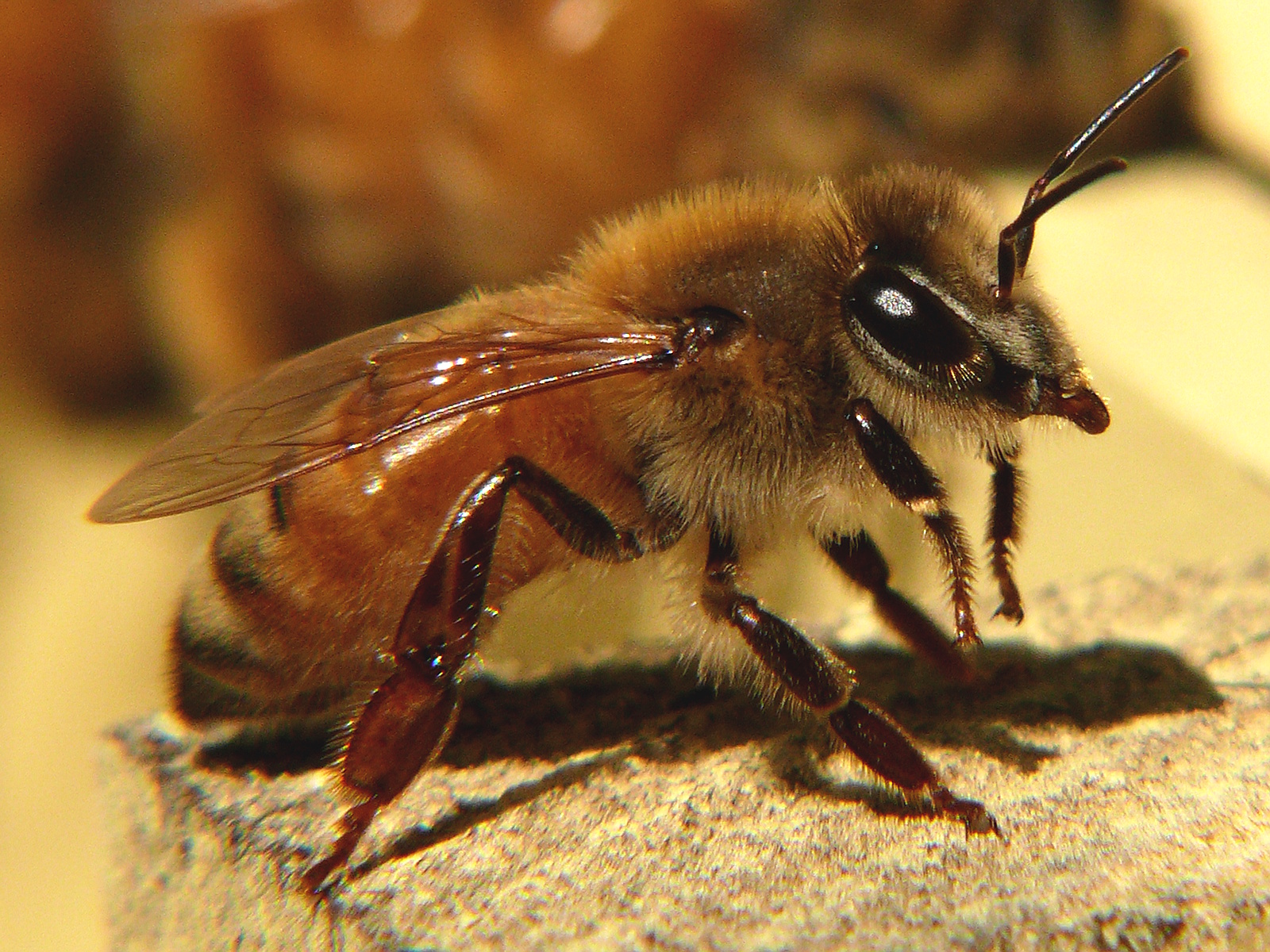- Italian bee
Taxobox
name = Italian bee
status = secure

image_width = 300px
regnum =Animal ia
phylum =Arthropod a
classis =Insect a
ordo =Hymenoptera
familia =Apidae
genus = "Apis"
species = "A. mellifera"
subspecies = "A. m. ligustica"
trinomial = "Apis mellifera ligustica"
trinomial_authority = Spinola, 1806"Apis mellifera ligustica" is the Italian bee which is a
sub-species of theWestern honey bee ("Apis mellifera").Origin
The Italian honey bee originates from the continental part of
Italy , South of theAlps , and North ofSicily . Thesubspecies may have survived the lastice age in Italy. It is genetically a different subspecies than the subspecies from theIberian peninsula and from Sicily. It is the most widely distributed of allhoney bee s, and has proved adaptable to mostclimate s fromsubtropical to cool temperate, but it is less satisfactory in humidtropical regions.Italian bees, having been conditioned to the warmer climate of the central
Mediterranean , are less able to cope with the "hard"winter s and cool, wet springs of more northernlatitude s. They do not form such tightwinter cluster s. More food has to be consumed to compensate for the greater heat loss from the loose cluster. The tendency to raise brood late inautumn also increases food consumption.Anatomy
*Color: Abdomen has brown and yellow bands. Among different strains of Italian bees there are three different colors: Leather; bright yellow (golden); and very pale yellow (Cordovan).
*Size: The bodies are smaller and their overhairs shorter than those of the darker honeybee races
*Tongue length: 6.3 to 6.6 mm
* MeanCubital index : 2.2 to 2.5Disease Resistance
There is no clear evidence that "ligustica" are any more resistant to acarine mites than the Northern dark bee. They also appear to be less tolerant of "
Nosema " than Northern dark bees. They are unable to retainfaeces in the gut for long periods and require more frequent cleaning flights than the dark bees. They are affected by the parasiticvarroa mite , Tracheal Mites, and the bacterial diseases European Foulbrood, American Foul Brood, Chalkbrood and otherdiseases of the honey bee .Behavior
beneficial
*shows strong disposition to breeding and very prolific
*excellent housekeeper (which some scientists think might be a factor in disease resistance)
*uses little propolis
*excellent foragers
*superb comb builders
*covers thehoney with brilliant white cappings
*shows lower swarming tendency than otherWestern honey bee races
*for areas with continuous nectar flow and favorable weather throughout the summernot beneficial
*more prone to drifting and
robbing than the other principal races of Europe.
*Often the strong brood rearing disposition and resulting large food consumption in late winter or early spring causes spring dwindling and hence slow or tardy spring development
*brood rearing starts late and lasts long into late Summer or Autumn, irrespective of nectar flow
*tends to forage over shorter distances than either "carnica" or "mellifera", and may therefore be less effective in poorer nectar flows.
*apparently lacks the ability to ripen heather honey before sealing.
*for cool maritime regions
*for areas with strong spring flow
*for areas with periods of dearth of nectar in the summerCharacter
It has a reputation for gentleness, but hybrids with the darker races can be especially vicious.
elective breeding
Breeders of Italian bees as well as other honey bee races look for certain beneficial characteristics. Depending on the breeding goal one or more of the following characteristics will be emphasized.
#Gentleness or excitability
#Resistance to various diseases and the tracheal mite plus the Varroa mite
#Early spring buildup in population
#Wintering ability
#Not prone to excess swarming
#Ripens honey rapidly
#Honeycomb cappings are white
#Minimal use of propolis
#Availability and queen cost
#ColorSource: [http://www.tnbeekeepers.org/pubs/The%2520Best%2520Bee.pdf] George Imrie's pink pagesWorldwide Distribution
*1814 introduced into the
United Kingdom
*1853? introduced toGermany
*1839 introduced intoNew Zealand
*1859 introduced to theUSA
*1862 introduced toAustralia , on 9 December into Victoria aboard the steam ship Alhambra
*1866 introduced toFinland
*1884 (Easter) introduced toKangaroo Island South Australia, sourced from Brisbane where they were previously imported in 1880 from Italy by Chas. Fullwood. It's possible Jas. Carroll had Italian bees in Brisbane by April 1875, but he certainly had them in 1877 when Angus Mackay accompanied a hive or hives of bees aboard the City of New York, packaged by Harbison in California. After a week's stopover in Sydney, the bees arrived in Brisbane. (Source: Barrett, P. "The Immigrant Bees, 1788 to 1898", Vols. I-III)ee also
Wikimedia Foundation. 2010.
